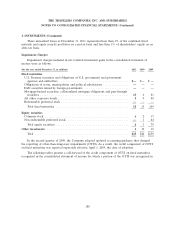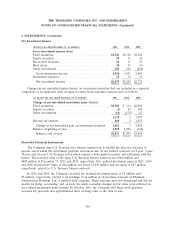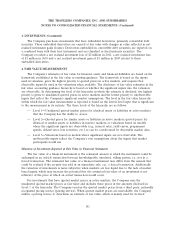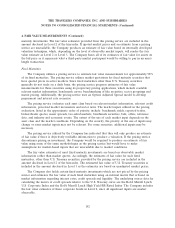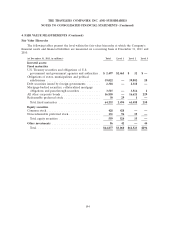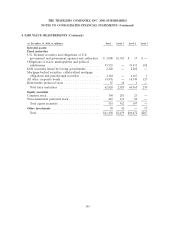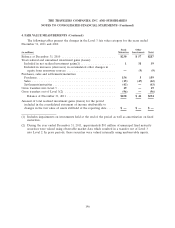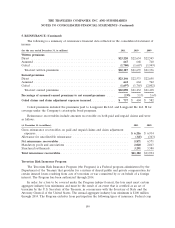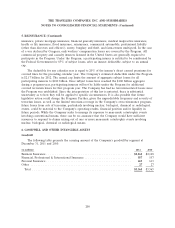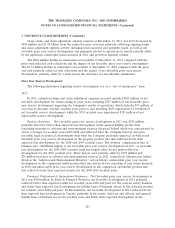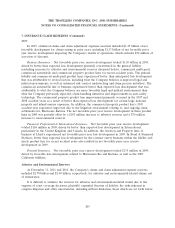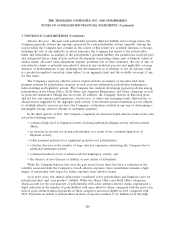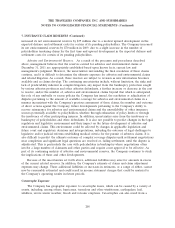Travelers 2011 Annual Report Download - page 210
Download and view the complete annual report
Please find page 210 of the 2011 Travelers annual report below. You can navigate through the pages in the report by either clicking on the pages listed below, or by using the keyword search tool below to find specific information within the annual report.THE TRAVELERS COMPANIES, INC. AND SUBSIDIARIES
NOTES TO CONSOLIDATED FINANCIAL STATEMENTS (Continued)
4. FAIR VALUE MEASUREMENTS (Continued)
Company produces an estimate of fair value based on internally developed valuation techniques which
are based on a discounted cash flow methodology and incorporates all available relevant observable
market inputs.
The fair value of commercial paper included in debt outstanding at December 31, 2011 and 2010
approximated its book value because of its short-term nature.
5. REINSURANCE
The Company’s consolidated financial statements reflect the effects of assumed and ceded
reinsurance transactions. Assumed reinsurance refers to the acceptance of certain insurance risks that
other insurance companies have underwritten. Ceded reinsurance involves transferring certain insurance
risks (along with the related written and earned premiums) the Company has underwritten to other
insurance companies who agree to share these risks. The primary purpose of ceded reinsurance is to
protect the Company, at a cost, from losses in excess of the amount it is prepared to accept.
Reinsurance is placed on both a quota-share and excess of loss basis. Ceded reinsurance arrangements
do not discharge the Company as the primary insurer, except for instances where the primary policy or
policies have been novated.
The Company utilizes general catastrophe reinsurance treaties with unaffiliated reinsurers to
manage its exposure to losses resulting from catastrophes. In addition to the coverage provided under
these treaties, the Company also utilizes a catastrophe bond program and a Northeast catastrophe
reinsurance treaty to protect against losses resulting from catastrophes in the Northeastern United
States. The Company also utilizes an excess-of-loss treaty in its National Property business unit of the
Business Insurance segment to protect against earthquake losses up to a certain threshold.
The Company evaluates and monitors the financial condition of its reinsurers under voluntary
reinsurance arrangements to minimize its exposure to significant losses from reinsurer insolvencies. In
addition, in the ordinary course of business, the Company may become involved in coverage disputes
with its reinsurers. Some of these disputes could result in lawsuits and arbitrations brought by or
against the reinsurers to determine the Company’s rights and obligations under the various reinsurance
agreements. The Company employs dedicated specialists and strategies to manage reinsurance
collections and disputes.
Included in reinsurance recoverables are certain amounts related to involuntary reinsurance
arrangements. The Company is required to participate in various involuntary reinsurance arrangements
through assumed reinsurance, principally with regard to residual market mechanisms in workers’
compensation and automobile insurance, as well as homeowners’ insurance in certain coastal areas. In
addition, the Company provides services for several of these involuntary arrangements (‘‘mandatory
pools and associations’’) under which it writes such residual market business directly, then cedes 100%
of this business to the mandatory pool. Such participations and servicing arrangements are arranged to
mitigate credit risk to the Company, as any ceded balances are jointly backed by all the pool members.
Also included in reinsurance recoverables are certain amounts related to structured settlements.
Structured settlements are annuities purchased from various life insurance companies to settle certain
personal physical injury claims, of which workers’ compensation claims comprise a significant portion.
In cases where the Company did not receive a release from the claimant, the structured settlement is
included in reinsurance recoverables as the Company retains the contingent liability to the claimant. In
the event that the life insurance company fails to make the required annuity payments, the Company
would be required to make such payments if and to the extent not paid by state guaranty associations.
198


